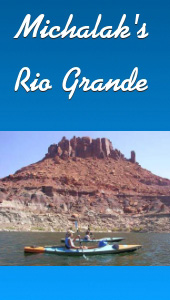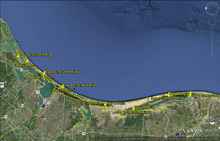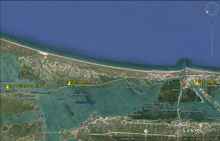
 Custom Search
|
| boat plans |
| canoe/kayak |
| electrical |
| epoxy/supplies |
| fasteners |
| gear |
| gift certificates |
| hardware |
| hatches/deckplates |
| media |
| paint/varnish |
| rope/line |
| rowing/sculling |
| sailmaking |
| sails |
| tools |
| join |
| home |
| indexes |
| classifieds |
| calendar |
| archives |
| about |
| links |
| Join Duckworks Get free newsletter CLICK HERE |
|
|
| A Small Effort – Rowing the 2015 Texas 200 |
by Kelly Davis - Dallas, Texas - USA and, Chuck Pierce - Port Arthur, Texas - USA |
Part 4 part 1 - part 2 - part 3 - part 4 - part 5 - part 6 Wednesday morning welcomed me with the skiff sitting 30 yards from the water. The sun was cresting the ridge to my east. I figured I would worry about it after I had a little breakfast, for today I was rowing into uncharted territory. Last year I had reached this area and turned northward to end the trip at Port Aransas. The peak of this adventure, my summit, was to be today. The Corpus Christi Channel combines with two other channels to form a busy crossroads of vessel traffic headed outbound and inbound from the Gulf. I proved I could do the first 100 miles; this is the second time I’d done it. My only option was move forward. Standing, I leaned into the task of completing what I had dreamed of, planned for. The feeling is not unlike leaning into a strong wind blasting me, trying to push me down. Gathering my gear, I see coyote tracks all around my sleeping pad. I look up to see if they are watching and see two large hogs ambling across the playa about 50 yards away. The camera battery looks like a salt brick, so cell phone camera and video stills will have to be relied upon.
Reaching the edge of the ferry crossings, I sit and watch to see if there is a pattern I could use to time my passing through the five ferries working back and forth. Hailing them on the radio did nothing. I passed the eastern ferry docks with two pulling out and three coming in. No problem. Breathing much too fast, I had to mentally and physically slow down to stay focused. I stopped to talk with the guys fishing on the public pier. They could not believe I had put in at Port Isabel. Neither could I. The final channel crossing laid about one hundred yards ahead. Lining up on the back end of the motel, about to cross I hear a motor revving up. I see a white 60-ish foot sport fisherman with outriggers waving, headed my way. With bow high and not on plane yet, the boat passes me and leaves behind a massive wake, from where I’m sitting. Pulling hard I quickly aim the stern into the face of the wake. The St. Lawrence skiff has proven itself seaworthy again. Cutting the initial wake was no problem, dropping into the trough behind that was not what I expected. The hotel and horizons disappeared; I guess the wake was six feet high. Running through my mind in milliseconds were thoughts of how to recover all my gear when the skiff swamps. Surprisingly, she rose up as the crest reached the stern like a duck on a pond. The three following wakes were no problem. Pulling hard on the oars I crossed the channel in moments. As I reached the channel marker on the north side, another large sport fisherman was headed out of Lydia Ann Channel. Not on plane yet, he turned towards the Gulf and I rode more scary wakes as he passed. With my mountain peak climbed, I relaxed a bit and refilled my water bottles and mixed up some Gatorade as the skiff glided past two parked barges. The sounds of the ferries and large boats faded into the distance as I was rowing through an area of flat water, not even a ripple. Duck hunting blinds dotted the water and shoreline reinforcing the complete change of scenery. The morning haze had burned off completely as I ghosted behind Mud Island headed towards Hidden Pass. As I reached the Pass, I could see cattle grazing in vibrant green grass along the shore with a ranch house and windmill. The sky was bright blue with white cumulus clouds forming, with one low grey cloud sprinkling down on me. Reaching Hidden pass was like stepping into a new environment. The water color cleared up from the muddy complexion through the channels. The shoreline has changed from sand and mud to stark white oyster banks. This type of beach is known to shred hull bottoms, centerboards, and unprotected feet. The wind freshened up and the waves grew a bit as I headed on towards Paul’s Mott. There was no one particular direction the waves were coming from; a confused chop by all definitions. Crossing Aransas Bay, I followed close to the back side of the barrier island. The shorebird rookeries were full of pelican, terns, skimmers, and seagulls, all segregated into their own groups. Each group had several sentries that would come out and berate me for interrupting their peace and privacy. Except for the pelicans, they just nodded as I rowed by. I pulled up to Paul’s Mott at about 3PM. Paul’s Mott is a triangle of oysters jutting into Aransas Bay, one of the stopping points for this year’s 200. Getting out to stretch I understood all the warnings about the oyster shells mighty quickly. I could hear and feel the razor sharp oysters modifying the skeg’s fiberglass sheathing. The terns were very upset that I had disturbed their peace and quiet as I walked along the south shore. Again, the pelicans just nodded. I rowed around to the tip where a fisherwoman was and ate my lunch and re-assessed my day. Rowing through the waves and chop would put me at the Third Chain of Islands at about 6PM and camping spots close by aren’t obvious in this area. I planned on rowing towards the Third Chain and then re-assessing as I approached. As the day wore on, wind held steady at about 15 mph. White caps here and there accentuated the beautiful scenery of the back side of San Jose Island. The offshore platforms being built lying on their sides faded in the west. The wind and waves were wearing on me and it was decision time. I decided to duck behind the spoil islands of the ICW and cruise along the channel to find a suitable camping area. Up close, the spoil islands are much different from the aerial photo charts. Pulling behind the first island, the land reached upward 50-60 feet, blocking all wind on this portion of the ICW. The brine flies and greenheads were swarming around the boat. Even rowing to the landward side of the channel didn’t stop the swarms. A barge with pusher was stopped along the back side of the spoils in a staging area. The captain questioned my sanity and said he was waiting on a berth in Corpus Christi. Pushing on I kept looking for a landing area but the spoils islands had thick, non-inviting, brush and rambles right to the edge. Landward the riprap and warning signs about trespassing encouraged me to continue on. Landward the shoreline came to an end a point of riprap with a breeze flowing across it. This opened up into what is the aptly named Sundown Bay, a small lagoon off the ICW. The spoil island was low and far enough away to allow the breeze to keep this area free of flies. The sun was approaching the horizon as I tied off to the riprap and let out all of my anchor line. The welcome breeze kept me pointed into the small bay that was calm with very green shorelines of riprap and low bushes. Checking the NOAA weather reports I could be confident the wind would continue through the night. If the wind shifted to the north, I would be dangling into the ICW and in the way of barge traffic. Directly off my stern the sunset was again, glorious. Setting up the mosquito netting and sleeping pad I prepared for the night.
A blinding white light woke me up. Thoughts of train headlights and UFO abductions raced through my foggy mind. A barge passing by was checking me out. Oh no, I had drifted into the channel! Jumping up I could tell that wasn’t the case and the light illuminated my position very well. The light went out as the barge continued droning toward me. Settling down, I turned my back to the barge. The captain must have not believed his eyes as he lit me up two more times as he passed. Two more barges checked me out through the night. Not a good night’s sleep, but it was very comfortable. to be continued... |
To comment on Duckworks articles, please visit one of the following:
|
 |





